How to properly water beets with salt water - proportions of the solution and instructions for processing a vegetable for its sugar content
As a vegetable crop, beets began to grow before our era. For the first time this vegetable was domesticated and cultivated on the islands of the Mediterranean Sea. This is partly due to the fact that this vegetable loves feeding with salt water.
In the coastal regions of the Mediterranean, the sea wind has saturated the soil with fine crystals of sea salt for centuries. Over time, the presence of salt in the soil became a prerequisite for normal growth and maturation of the root crop. Surprisingly, in order for the beets to grow sugary and tasty, they are periodically watered with water and salt. How and when to pour salt water on beets so that they are sweet, we will tell in the article.
The content of the article
The benefits of salt feeding
To obtain a good harvest of root crops, plants are fed throughout the entire period of their growth. The most effective method of fertilizing is watering with water in which mineral mixtures are dissolved. So the plants get the necessary nutrients faster.
Beetroot crops have an increased need for sodium during growth and development. This chemical element is often lacking in heavy, dense soils of central Russia. Therefore, the cultivation of beets here does not give the best yields.
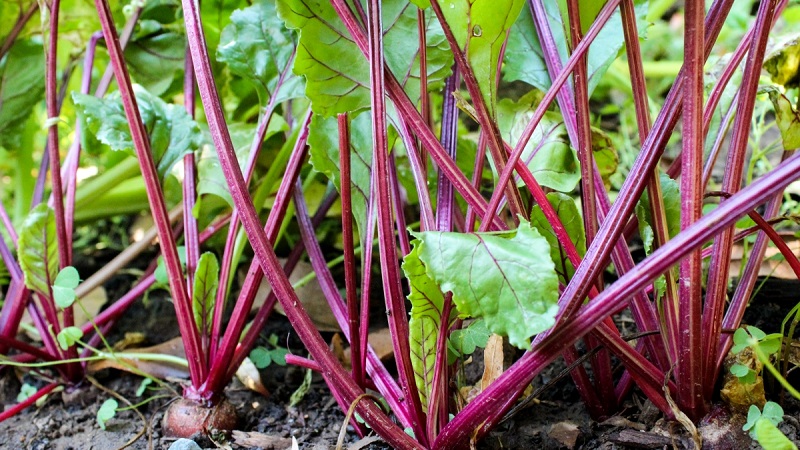
What gives watering beets with water and salt
All varieties of beetroot crops are sensitive to the lack of sodium in the soil. This chemical element is the main component of common table salt. Regular application of brine to the soil replenishes the sodium content of the soil.
It's important to know. The presence of red streaks on the beet tops and redness leaves indicates a lack of sodium.
The excellent taste and sugar content of root crops are determined by the presence of a sufficient amount of nutrients in the soil. When growing beets in the open field, well-organized watering, including watering with salt water, allows you to grow large and tasty vegetables.
In addition, spraying the tops with brine is an excellent preventive measure against pests.
Correct preparation of saline solution
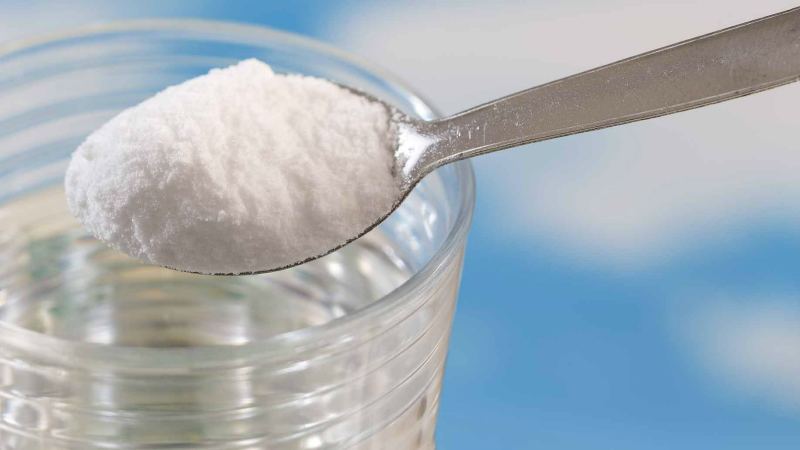
Regular inspection of the appearance of beet tops will help you learn about the lack of sodium in the ground in time. When the beet leaf begins to turn red, red streaks appear, which means it's time to water the beet beds with salt water.
Attention... When watering with salt, it is important to observe the measure. The principle "you can't spoil porridge with butter" does not work here. Excess sodium, as well as other elements, is detrimental to the root crop.
Instructions for preparing a solution for irrigation
When watering beet plantings with salt water, the proportions for the saline solution are determined based on the appearance of the tops. If the beet greens look healthy, do not make a strong solution. Enough 1 teaspoon of table salt in 10 liters of warm water. This amount of liquid is used to water 1 m² of the garden.
When the leaves turn red, signaling a lack of sodium, the dose of salt is increased to 2 tablespoons per 10 liters of water. This amount of solution is poured over 1 m² of plantings.
The proportions given are for the preparation of a mixture of coarse rock salt. When using fine salt "Extra", its amount is reduced by 2-3 times.
The salt dressing recipe contains only two ingredients: water and salt.
The procedure for preparing a solution for irrigation is as follows:
- heat a glass of water in a small container;
- add salt;
- stir thoroughly until the salt crystals are completely dissolved;
- dilute the resulting mixture with the remaining volume of water.
The water used for irrigation is collected in the container in advance so that it has time to warm up to ambient temperature. For watering beets, like other garden crops, do not use cold liquid. Violation of this rule inhibits plant growth and provokes the development of diseases.
If you are using chlorinated water for irrigation, pour it into a suitable container in advance and let it stand for several days. Then carefully drain the water, being careful not to stir up the chlorine that has settled at the bottom.
What is the best way to water vegetables? Experienced gardeners rightly believe that soft rainwater is best suited for watering garden crops. To collect rainwater, several special containers are installed on the site. If it is not possible to collect rainwater, then hard tap water is softened by adding wood ash (about 50-60 g per 20 liters of water).
Salt dressing and processing of beet tops
The first watering with a salt solution is carried out when 4-5 young leaves develop on the plant. The optimal amount of salt dressings is two or three per season. The last time the beets are watered is about 30 days before the roots are removed from the garden.
In addition to watering, another method of applying salt dressing is known - spraying. For the procedure, use the same solutions.
In addition to enriching the soil with nutrients, the salty liquid protects the plantings from insect pests, fungal diseases and infections. For preventive purposes, the plants are sprayed with a weak salt solution.
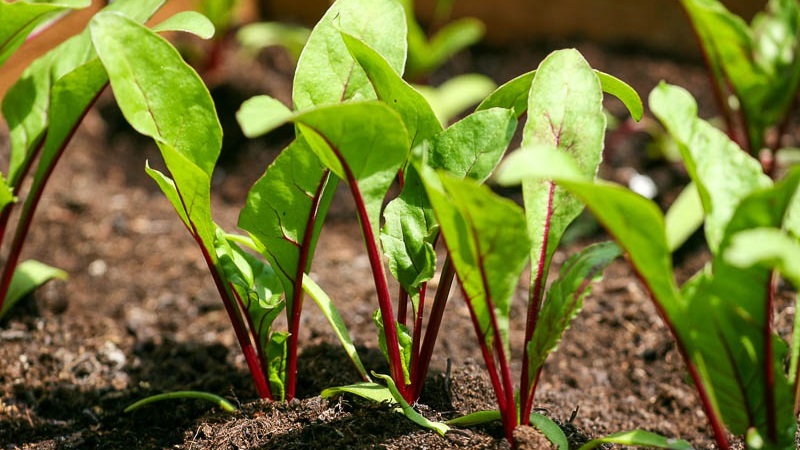 If pests or fungi have already appeared, processing the leaves with a strong salt solution (2 tablespoons per 10 liters of water) will help. When processing, not only the upper, but the lower side of the leaf, as well as the soil around the plants, are moistened.
If pests or fungi have already appeared, processing the leaves with a strong salt solution (2 tablespoons per 10 liters of water) will help. When processing, not only the upper, but the lower side of the leaf, as well as the soil around the plants, are moistened.
The procedure is carried out using conventional spray equipment. This can be an electric or manual sprayer, or various devices of our own manufacture.
Salt is not a hazardous toxic substance, but it can irritate mucous membranes and skin. Therefore, the use of protective goggles and gloves is recommended.
Frequency and intensity of watering
To obtain a good harvest of beets, root dressing is combined with the correct irrigation regime. The moisture content of the soil is of particular importance at the time of germination. seed and before the shoots appear. At this time, drying out of the soil will lead to the death of the crop.
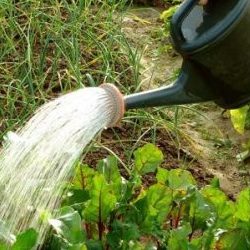 After the emergence of seedlings, the crops are watered as the top layer of the soil dries up. Deep moistening of the soil during this period is not yet required.
After the emergence of seedlings, the crops are watered as the top layer of the soil dries up. Deep moistening of the soil during this period is not yet required.
When an outlet of several green leaves appears, the first feeding is carried out with salt water. If there are no obvious signs of sodium deficiency, then watering is carried out with slightly salted water (1 tsp. Salt per 10 liters of water).
During the period of development and formation of root crops, beet beds are watered abundantly once every 7-10 days. Grown plants absorb moisture at a depth of 10-15 cm, so it is necessary to monitor deep soil moisture. For irrigation use 2-3 buckets of water per 1 m².
The second time, the saline solution is applied about a month before the harvest, when the diameter of the fruits reaches 5-6 cm. Depending on the severity of the sodium deficiency, a weak or strong solution is used.
Watering the beet beds is completely stopped about 3 weeks before the root crops are removed from the garden. This will make the beets more sugary and dry before harvesting.
Tips & Tricks
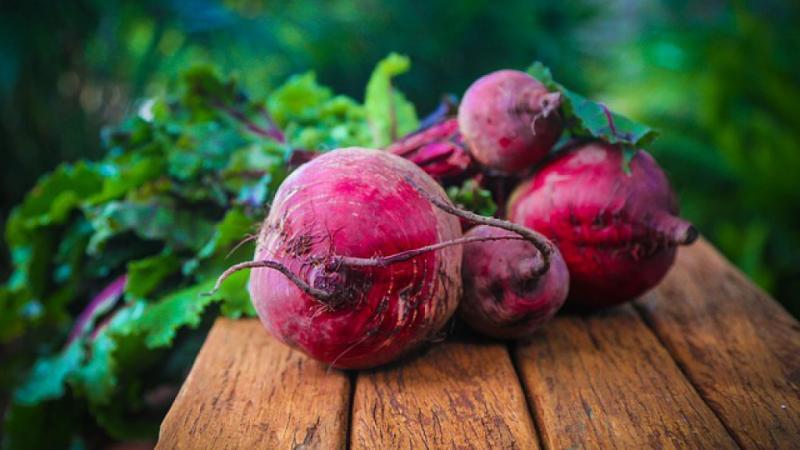
Periodic inspection of the beet tops will help determine if the roots need sodium, boron, potassium, or other trace minerals. With a lack of nutrients, the leaves become small, flat and turn red.
Important... Healthy beet leaves are large, slightly wavy, with a rich emerald green color. Depending on the variety, only the leaf petiole or also the veins can be red.
You can feed the root crops with special complex fertilizers for beets. The manufacturer indicates the proportions in the instructions for the preparation. But periodic watering with salted water also gives good results.
In cold water, salt dissolves slowly. If using cool water for irrigation, make sure the salt is completely dissolved in the water. When watering, do not allow salt crystals to get on the plants.
Too high a concentration of brine is dangerous for beets, especially for young plants. Therefore, when preparing the feeding liquid, observe the ratio of salt to water.
In addition to adding sodium to the soil, it is useful to feed the beets with boron, potassium and phosphorus. To enrich the soil with boron, 10 g of boric fertilizers are dissolved in 10 liters of water.
Wood ash will help improve the composition of the soil. It is sifted, poured over with water, insisted and watered with the resulting solution.
Complex fertilizers are used to saturate the soil with potassium and phosphorus, which are necessary for the formation of a root crop and the accumulation of sugary substances in it. Top dressing is applied in accordance with the instructions for the preparation.
Read also:
The best recipes for pickled beets for the winter in jars.
Conclusion
Periodic use of salt water when watering beet beds gives the fruit sweetness and improves its taste. When calculating the salt concentration, they are guided by the severity of sodium deficiency. If the plants look healthy, watered with a slightly salted solution. If the beet tops are small and red in color, use a concentrated composition.
It is important to observe the proportions when pointing the composition for irrigation. Too much sodium is just as bad for beets as too little sodium.
Thank! It's a pity that I missed the first watering.
Nothing, don't forget next time)